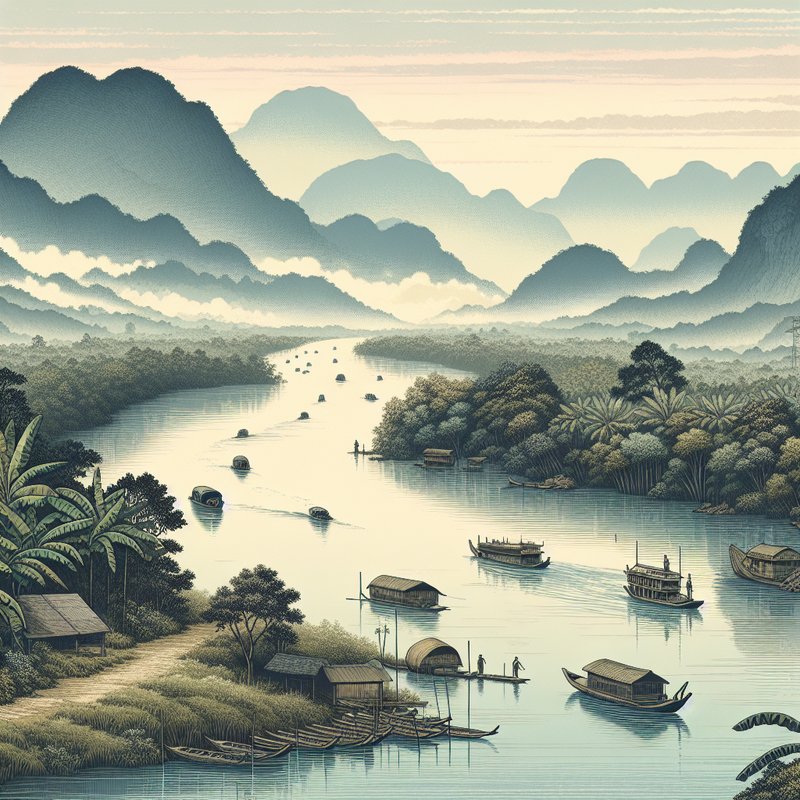The Cultural Significance of Vietnam’s Rivers

Rivers have always played a crucial role in the cultural landscape of Vietnam. They are not just a source of water, but also lifelines for communities, shaping their traditions and way of life.
The Mekong River, for instance, is often referred to as the “Mother River” by the local communities. It supports fishing, farming, and transportation, and is deeply woven into the fabric of daily life. Festivals and rituals revolve around the river, celebrating its abundance.
Moreover, rivers hold a significant place in Vietnam’s folklore and art. Many esteemed poets and writers find their muse in the flowing waters, weaving narratives that echo the rivers’ serene beauty and profound importance to the Vietnamese people. These waterways are vividly portrayed in traditional paintings, capturing their essence and the life they sustain. Furthermore, songs passed down through generations often celebrate the rivers, showcasing their influence on the cultural identity and emotional landscape of local communities. This artistic representation highlights the enduring bond between the people of Vietnam and their rivers, underscoring how these natural features are not just physical entities, but also pivotal elements of cultural heritage and storytelling.
The Ecological Importance of Vietnam’s Rivers

The rivers of Vietnam are not only vital for human existence but also serve as essential ecosystems. They are home to diverse flora and fauna, supporting a variety of wildlife that is unique to the region.
For instance, the Mekong Delta is known for its rich biodiversity, including numerous fish species and waterfowl. This ecological wealth provides not only for the local communities but also contributes to global biodiversity, highlighting the need for conservation efforts.
Furthermore, the rivers act as natural filters for the environment, helping to cleanse water and maintain the health of the surrounding ecosystems. The intricate network of river systems promotes water circulation, dilution of pollutants, and sediment restoration, leading to a balanced aquatic environment. Understanding their ecological role encourages responsible tourism and sustainable practices among visitors and locals alike. This awareness fosters a deeper appreciation for the rivers’ contributions to the environment, urging tourists to engage in activities that are mindful of preserving these vital waterways.
Recreational Activities Along the Rivers

The rivers of Vietnam offer a plethora of recreational activities that appeal to both locals and tourists. From boating and fishing to cycling along riverbanks, there are numerous ways to enjoy these beautiful waterways.
Kayaking in the Ha Long Bay or cruising the Mekong Delta allows tourists to experience the stunning landscapes while getting closer to the local life. These activities provide unique perspectives of Vietnam’s natural beauty and are often combined with cultural experiences, such as visiting floating markets.
Moreover, many festivals held on the rivers, like the Hoi An Lantern Festival, offer visitors a chance to engage with Vietnamese culture while enjoying the scenic river views. Such events foster a sense of community and provide insight into local traditions.
Life Along the Riverbanks: Communities and Traditions

The communities living along Vietnam’s rivers have developed unique ways of life that are closely tied to the water. Many local families engage in traditional fishing practices or farming, relying on the river for their livelihoods.
In the Mekong Delta, residents often engage in aquaculture, raising fish and shrimp in floating cages, a practice that showcases sustainable living and adaptation to the river’s ecosystem. Community festivals such as the River Fish Festival and local harvest celebrations often highlight these traditions, where families gather to share their catch and honor the river’s bounty. These events not only promote the preservation of local cultures but also emphasize the importance of maintaining a harmonious relationship with nature. Celebrating these practices fosters a sense of pride among the communities and helps preserve the unique cultural identity tied to the waterways.
Additionally, the riverbanks are typically bustling with local markets where fresh produce, handmade crafts, and traditional foods are sold. These vibrant marketplaces are a feast for the senses, filled with colors, aromas, and the sounds of local vendors calling out to customers. Fresh fruits and vegetables, often harvested from the fertile lands surrounding the rivers, are displayed in abundance, showcasing the rich agricultural heritage of the region.
Visitors can find a variety of handmade crafts, such as intricate bamboo products, traditional pottery, and unique textile items, each telling a story of the local culture and craftsmanship. The markets also serve as a platform for local chefs and food enthusiasts to showcase traditional Vietnamese dishes, from sizzling street foods to sweet desserts made with local ingredients.
This vibrant marketplace not only provides local residents with essential goods but also attracts visitors eager to experience authentic Vietnamese culture. Engaging with local vendors and sampling the different offerings allows tourists to immerse themselves in the warm hospitality of the communities, creating memorable moments and connections along the waterways of Vietnam.

Leave a Reply